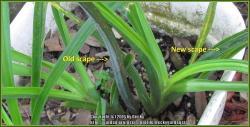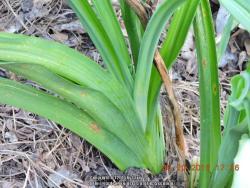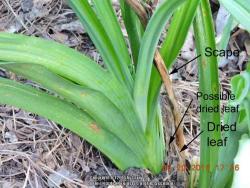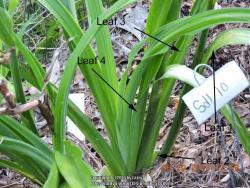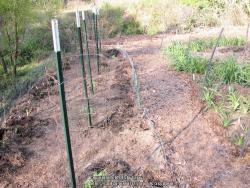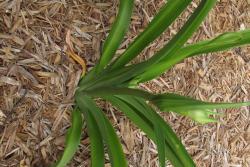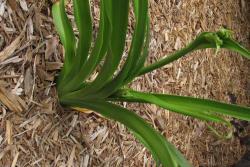@seedfork
To know if there are two scapes on the same fan one would have to examine the growth pattern of the fan very closely. We would need to look at the normal growth pattern of leaves and then compare that with the pattern of leaves on the plant with multiple scapes.
If we label the two sides of a fan as left and right then if a leaf has been produced on the right side the next leaf is produced on the left side and the next leaf after that is produced on the right side again. The leaves are produced on alternate sides of the crown. When the growing point becomes the scape it should have a leaf on the left and a leaf on its right side. The pattern would look like this < s > where < is a leaf on the left side and > is a leaf on the right side, s represents the scape. The pattern for the entire fan might look like this <<<<< s >>>>>> The fan had 11 leaves, five "left" leaves and six "right leaves" and a scape.
Usually what happens after the scape has been produced, in cultivars that can rebloom and might do so, is that a new fan starts to grow new leaves after the first scape has been produced. The pattern for the "fan" from above might look like this when the first new leaf is produced <<<<< > s >>>>>>
The pattern for the "fan" from above, after the five new leaves have been grown by the new replacement fan would look like this <<<<<<<>>>s>>>>>>
There are 16 leaves in the pattern. Eleven of the leaves were produced by the original fan. Five new leaves were produced by the new replacement fan.
Now lets say that the new replacement fan produces its own scape. The pattern would become <<<<<<< s >>> s >>>>>>
Complications
Some of the leaves produced by the original growing point ("fan") may age, yellow and die naturally during the growth.
In a typical growing season and under average growing conditions, the axillary growing points will become buds and rest until the first scape starts to develop. That usually means that the last leaf produced by the original growing point would be large and the first leaf produced by the new replacement growing point would be smaller. So the pattern would be <<<<< (five larger leaves) <<>>> (smaller leaves becoming larger with each leaf) s (six larger leaves) >>>>>>
We would expect to see a large leaf on one side of the first scape and a somewhat smaller leaf on the other side. There should be a noticeable reversal of the normal sequence of leaf sizes. That is, normally the sequence is smaller leaves produced first and later leaves are larger. After the scape is produced the next leaf would be expected to be smaller since it would be the first leaf of the new growing point or bud.
However, I think that some crowns/fans grow so quickly in the appropriate locations and conditions that the new replacement growing point does not form a bud - it simply develops and grows as the leaves of the first fan are produced. So it becomes a large growing point before it produces its first leaf - the first leaf it produces is not as small as would be expected to have developed from a resting bud. Then we would have to carefully measure the length of the last leaf produced before the scape and the length of the first leaf produced after the scape. I have done this a couple of times and found that the first leaf produced after the scape is smaller than the last leaf produced before the scape.
My conclusion is that even when it appears that two scapes are produced by one fan they actually are not. To conclude that two scapes were produced by one fan (growing point) I would want to see that the length of the first leaf produced after the scape is longer or as long as (but is not shorter at all) than the last leaf produced before the scape.
